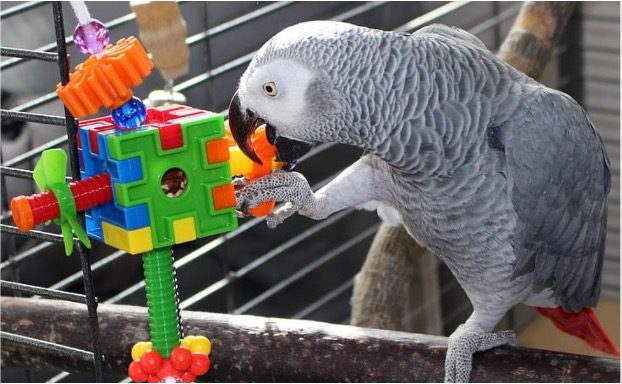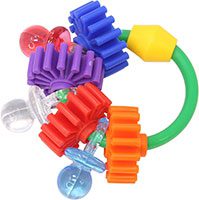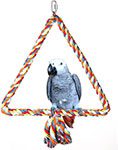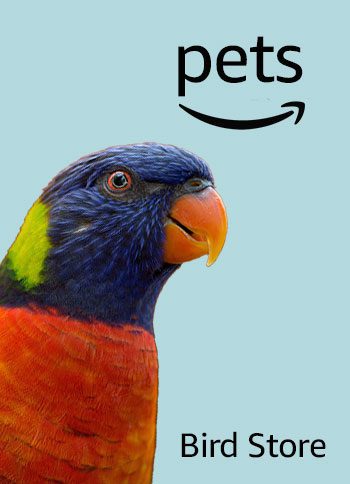As a good parrot parent, you do everything you can to take great care of your parrot. You feed them a balanced and nutritious meal, play with and cuddle them, and probably spend hours teaching them to sing, whistle and talk.
However, if you work 8–10 hours a day away from home, it means that your bird also spends a lot of time alone in their cage. As a result, they can get bored and lethargic, start picking at their feathers or even get moody when you come home. Providing your pet with engaging and entertaining toys may help you avoid these issues.
Why Playtime Is Important for Pet Birds
Birds kept as pets in a cage can't carry out the activities they would normally conduct in the wild. According to avian behaviourists who have spent time monitoring them in the wild, birds have a natural urge to chew and a daily need to seek food.
Scientists have also noted that a parrot's behavior in the wild is quite animated and playful. They have been seen chattering gleefully with the rest of the flock while tearing the bark off trees, biting off and hurling leaves and twigs, dangling from and climbing on vines and other such behaviors.
Pet birds still have a lot of instincts in common with their wild counterparts. Playing with toys is a crucial replacement for natural behaviors like nest building, grazing and interacting with their group.
What Toys Should I Get My Parrot?
Parrots aren't picky when it comes to toys. They enjoy a wide range of toys, from straightforward balls to more challenging puzzles for parrots. Anything that stimulates their mind and/or body is regarded as an excellent toy. Here are some choices that your pet bird might enjoy.
Puzzle Toys
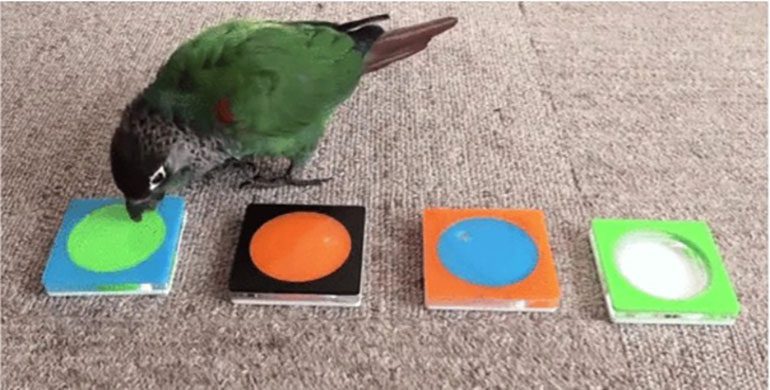
Puzzle toys are a favorite pastime for parrots. It gets their minds off of other things so they can finish the game or follow directions to obtain a treat.
Puzzle toys urge these birds to use their critical thinking skills to earn a treat rather than their beak's blunt force. Great options for puzzles for parrots include those that have places for food to be concealed, threaded on skewers, jammed into holes or otherwise incorporated within the toy. By challenging a bird's problem-solving skills, parrot puzzle toys help keep their minds active, preventing boredom.
Comfort Toys
In the wild, parrots enjoy snuggling up in trees with their partners, parents or siblings. Caged birds also like to snuggle with or squirm inside of plush, cozy items, especially when left alone. Having something to snuggle helps reduce anxiety and makes them feel safer as a result.
Soft, fluffy items that can be attached to the side of a cage for hugging and napping are excellent examples of comfort toys. They can also sleep and hide in tiny "huts" or tubes, which fall under this group. For a shy bird, a cuddler toy can be the appropriate hiding place. Some parrots may not do well in huts during the breeding season because they may become too attached to their favorite location.
Chewing Toys
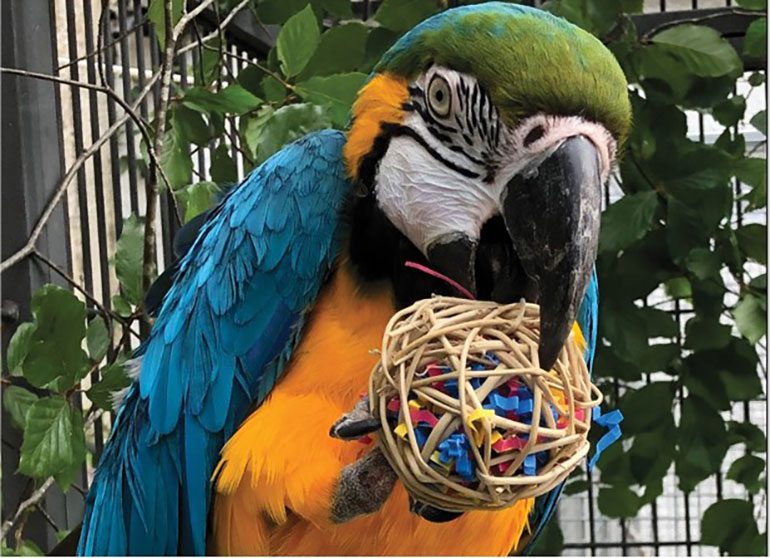
Birds love the act of chewing. It's a typical outdoor activity, especially during the breeding season when birds are occupied with boring nests into tree trunks.
So, providing your birds with items made of wood that can be destroyed is necessary. Items made of wood and leather provide long periods of pleasurable chewing. Don't panic or get offended if your pet bird eventually destroys the items; keep in mind that's the point.
Be aware that some parrots tend to be more destructive at particular times of the year, mainly when they are breeding. So make sure to keep plenty of chewing toys on hand for these periods.
Pull Toys
Toys called "pull toys" come with a variety of parts that your parrot can, well, pull. Aside from being fantastic for easing boredom, pull toys are also wonderful for aggressive pets. They allow birds to vent their anger on toys rather than on people and other animals.
To interest the parrot and allow for rough play, they are typically composed of brightly colored materials. They can come with pieces that slide back and forth or move up and down. These toys can also be "busy boards" that can be fastened to the cage's side or mobiles that can be pushed and spun.
Foot Toys
Small parrot toys that are easy to hold are called foot toys. These can be anything from tiny chunks of wood, rattles, barbells, rawhide pieces, little pieces of cholla, hard plastic toys that roll around and hard rubber chews. Foot toys can be placed inside the cage's toy bowl or toy chest. They work wonders as a beak diverter to stop your pet from biting your fingers. And playing with them on the floor is also enjoyable. Some birds enjoy wrangling with their foot toys while playing on their backs.
Movers and Shakers
A parrot's zygodactyl feet, which have two toes on the front and two on the back, allow them to execute a number of incredible acrobatic feats and have an outstanding ability to firmly hold trees.
Your feathered friend will undoubtedly like movers and shakers, including swings, rings, perches, perch toys (things with a hole to slip onto a perch), spiral perches, plastic chains and knotted ropes. A bird cage should always include a mover and shaker since it can provide countless possibilities for exercise.
The Importance of Changing Up Your Parrot's Toys Occasionally
Given their intelligence, these birds can get bored with a routine very quickly. To keep them engaged and content, their environment must be constantly changed, and this includes their play toys. Additionally, toys have several purposes, including promoting mental stimulation, enrichment and exercise. Rotating the toys gives your bird the chance to explore different hues, textures and forms. Additionally, it lessens the chance that your bird may become overly reliant on a single toy, which can cause anxiety and boredom.
As for how often you should change your bird's toys, this will depend on a variety of elements, including the personality, age and degree of activity of your bird. As a rule of thumb, consider rotating your parrot's toys every week or two. Pay attention to how your pet interacts with the toy to find out if it needs to be changed.
If your feathery pet has been ignoring the toy for a few days, this is a clear sign that the toy no longer holds their interest. It may also be time to replace it if there are obvious signs of severe wear and tear, such as frayed ropes or broken sections.

